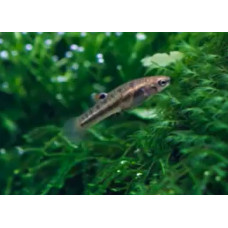Latin name
Heterandria formosa
Other name
Least killifish, dwarf topminnow, mosqu or midget livebearer.
Identification
Least killifish differ little in body shape from their closest relatives, the Poecilia. They have an elongated, laterally flattened body with a high tail.
Features of fish fins
As in most poeciliids, the male anal fin is modified into a gonopodium (internal organ) that is used to deliver sperm and fertilize females during mating. The male is distinguished from the female by the smaller size and shape of the anal fin. The female's fin is rounded, while the male's is rolled into a tube.
Fish colouring
Least Killifish are olive in color with a dark horizontal stripe down the center of the body. There is also a dark spot on the dorsal fin and females have a dark spot on the anal fin.
Distribution
The geographic range of this species covers the southeastern United States, from South Carolina southward to Georgia and Florida, and westward along the Florida Gulf Coast to Louisiana, so it has also been collected in eastern Texas.
Habitat
Tropical freshwater benthopelagic species. pH range: 7.0 - 8.0; dH range: 9-19.
Size
One of the smallest fishes and smallest vertebrates known to science. Males grow to about 2 centimeters (0.8 inches), while females are slightly larger at about 3 centimeters (1.2 inches). It is the smallest fish species native to North America. Life expectancy is approximately three years.
Behavior
Non-migratory species. Occurs primarily in vegetated, slow-moving or standing freshwater habitats, but also occurs in brackish waters.
Food and feeding habits
Least killifish feed primarily on aquatic invertebrates such as worms and crustaceans. They also eat plants. The position of the mouth of these fish allows them to eat small insects that fall into the water.
Reproduction
Livebearers. The male uses his modified anal fin, or gonopodium, to deliver sperm to the female. The fertilized eggs grow inside the female until the young hatch and are released into the water. Heterandria formosa has an unusual breeding strategy even among viviparous individuals: instead of releasing all the young at once, up to 40 young are released within 10-14 days, but sometimes for longer periods.
Fishing
This species is commercially important for fishing.
Relationship with a person
Harmless. It is one of the few aquarium fish endemic to North America.
| Classification | |
| Phylum | Chordata |
| Class | Actinopterygii |
| Squad | Cyprinodontiformes |
| Family | Poeciliidae |
| Genus | Heterandria |
| Species | H. formosa |
| Features | |
| Conservation status | Least Concern |
| Habitat | Pelagic |
| Life span, years | 3 |
| Maximum body weight, kg | No information |
| Maximum length, cm | 3 |
| Sailing speed, m/s | No information |
| Threat to people | Edible |
| Way of eating | Planktonophage |
Least killifish
Tags: least killifish




